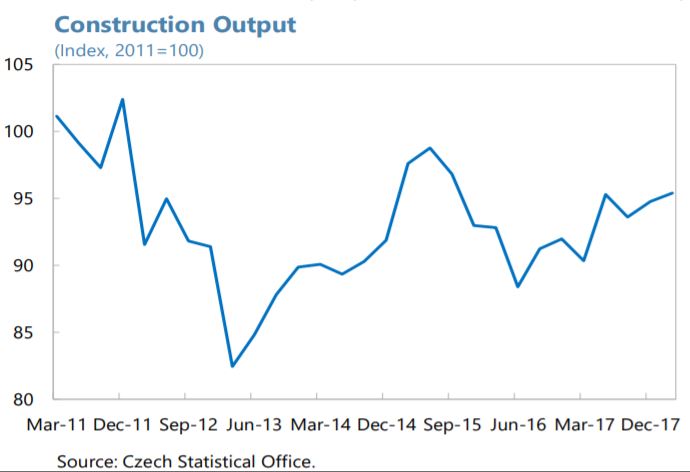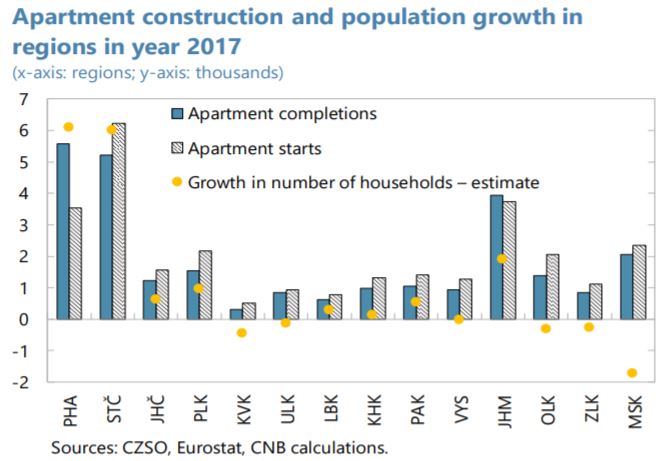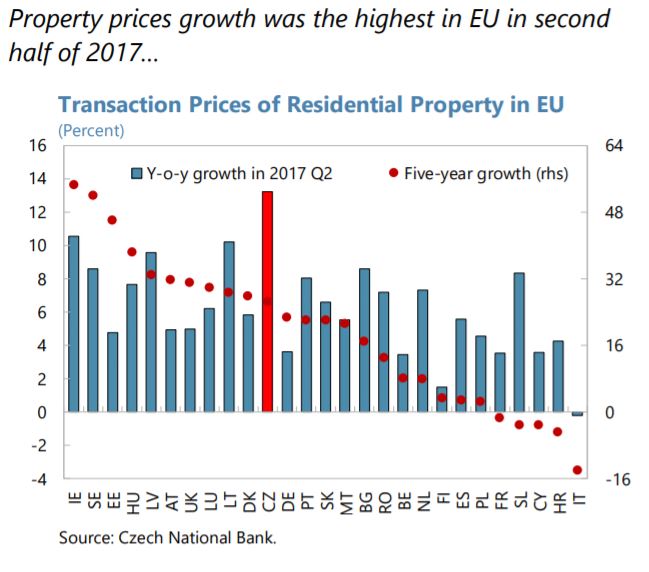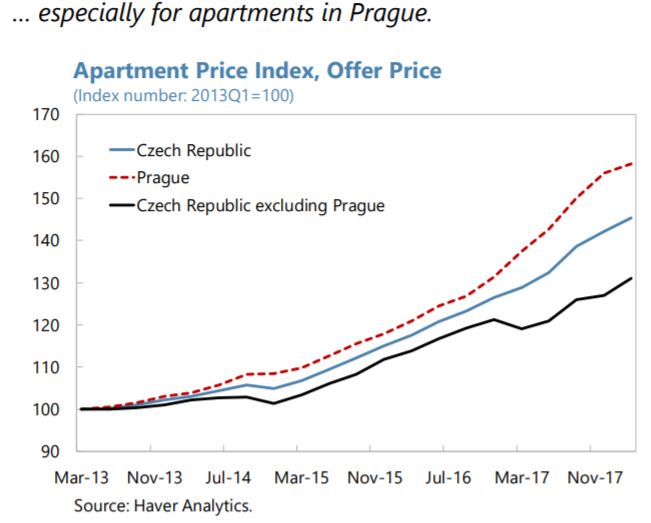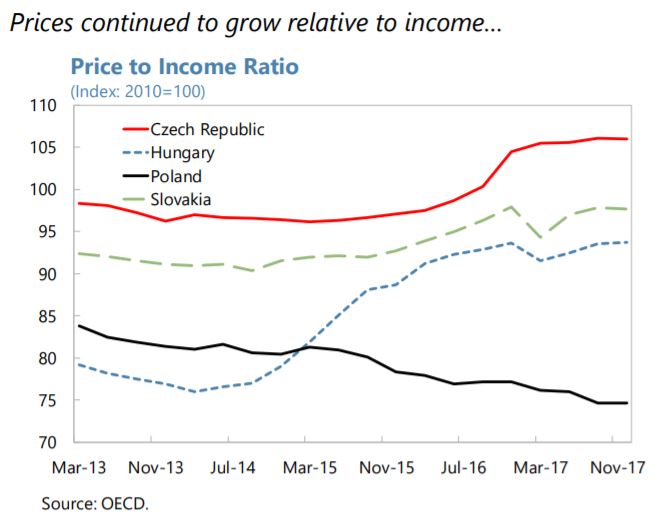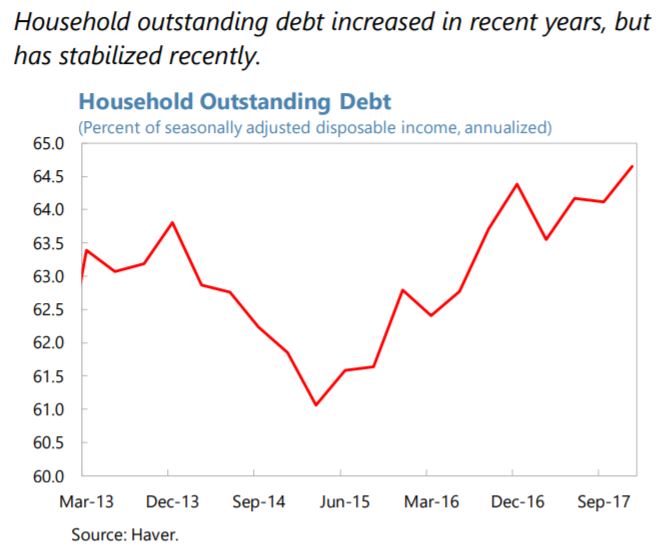Saturday, June 30, 2018
Housing Market in Czech Republic
The IMF’s latest report on Czech Republic says that:
“Construction activity declined after the financial crisis and has yet to recover to levels seen in 2009. The effect is particularly noticeable in Prague, for which housing completions have not kept pace with housing demand. Low numbers of housing starts imply that the problem will continue for some time. Demand has been driven mainly by migration within the country and strong demand for prime properties by foreigners; demand for investment properties is also believed to play a significant role.”
The report also says that:
“Private credit growth is in line with nominal GDP growth, but household lending is growing more quickly. Bank lending to residents eased to 4 percent (y/y) in April, of which loans to
resident non-financial corporations grew by only 1½ percent. However, loans to households
increased by 7½ percent; mortgage loans to households increased by 9½ percent, off the recent peak in mid-2017 of 10½ percent, but nonetheless outpacing nominal income growth. Consumer credit also grew relatively strongly.Some households are highly leveraged. The aggregate household debt-to-income (DTI)
ratio has not increased further over the year, given the strong growth of disposable income. But many households continue to borrow at high loan-to-income multiples (…), associated with escalating price-to-income and price-to-rent ratios (…).The CNB has tightened macroprudential recommendations (…). New, non-binding
recommendations implemented in 2017: Q2 included a 90 percent LTV cap on individual loans and a 15 percent cap on the share of new loans originated with LTV ratios between 80 and 90 percent. In June 2017, the CNB recommended that banks pay extra attention to debt-to-income and debt service-to-income ratios. Reported lending standards have subsequently tightened, and the share of new household mortgage loans with LTVs above 90 percent has declined, with many loans at around 80 percent LTV. However, concerns were expressed that this improvement may have been flattered by inflated valuations.Additional measures are needed to insure against household financial vulnerabilities. DTI ratios on new mortgages are only indirectly addressed by LTV restrictions—to safeguard
household finances, the financial authority needs more comprehensive tools and access to data sufficient for a comprehensive picture of households’ finances.
- The CNB should be given binding powers over maximum LTV, DTI, and Debt-Service-To-Income (DSTI) ratios as soon as possible. Debt-based measures would provide a more comprehensive assessment of financial risks than loan-based measures, and are increasingly standard in advanced economies. In the absence of legislation granting binding powers, the CNB should immediately issue recommendations over DTI and DSTI ratios, to reinforce those over LTVs and better target high leverage.
- If such “demand side” (i.e. borrower-based) tools are not implemented, additional “supply side” measures could be considered, but these would only indirectly address the underlying problem of high household leverage. Risk weight add-ons or minimum risk weights for property exposures could provide insurance against growing real estate exposures, but a substantial increase would likely be required to make a meaningful difference to lending conditions, given that capital ratios are above regulatory requirements. The CNB has discretion over capital requirements under Pillar II, but it is not guaranteed that the effects would “pass through” to mortgage borrowers.
Better data are needed for monitoring risks. The use of DTI and DSTI measures puts great
demands on data—to accurately assess risks and to be fully sure of compliance, the CNB needs access to comprehensive household loan data. Better data on commercial real estate transactions would also be helpful.Macroprudential measures should be supported by addressing fiscal and structural
policies. Increasing house prices in major metropolitan areas reflects equilibrium adjustment, and demand has consistently outstripped supply, especially in Prague. Planning and zoning laws contribute to housing supply constraints that add to pressures on prices. Some progress has been made in streamlining procedures for building permits, but construction levels remain below pre-crisis highs (…). In addition, the tax environment adds to housing demand (…). Without attention to such problems, the housing market is likely to remain tight.”
Posted by at 6:15 AM
Labels: Global Housing Watch
Subscribe to: Posts
